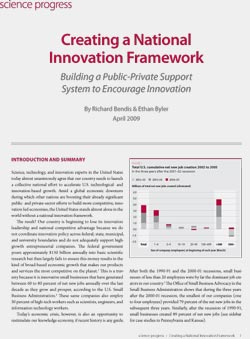Article Index
Creating a National Innovation Framework
Building a Public-Private Support System to Encourage Innovation
By Richard Bendis & Ethan Byler
April 2009
Introduction and Summary
Science, technology, and innovation experts in the United States today almost unanimously agree that our country needs to launch a collective national effort to accelerate U.S. technological- and innovation-based growth. Amid a global economic downturn during which other nations are boosting their already significant public- and private-sector efforts to build more competitive, innovation-led economies, the United States stands almost alone in the world without a national innovation framework.
 The result? Our country is beginning to lose its innovation leadership and national competitive advantage because we do not coordinate innovation policy across federal, state, municipal, and university boundaries and do not adequately support high-growth entrepreneurial companies. The federal government pours approximately $150 billion annually into basic scientific research but then largely fails to ensure this money results in the kind of broad-based economic growth that makes our products and services the most competitive on the planet.[1] This is a travesty because it is innovative small businesses that have generated between 60 to 80 percent of net new jobs annually over the last decade as they grow and prosper, according to the U.S. Small Business Administration.[2] These same companies also employ 30 percent of high-tech workers such as scientists, engineers, and information technology workers.
The result? Our country is beginning to lose its innovation leadership and national competitive advantage because we do not coordinate innovation policy across federal, state, municipal, and university boundaries and do not adequately support high-growth entrepreneurial companies. The federal government pours approximately $150 billion annually into basic scientific research but then largely fails to ensure this money results in the kind of broad-based economic growth that makes our products and services the most competitive on the planet.[1] This is a travesty because it is innovative small businesses that have generated between 60 to 80 percent of net new jobs annually over the last decade as they grow and prosper, according to the U.S. Small Business Administration.[2] These same companies also employ 30 percent of high-tech workers such as scientists, engineers, and information technology workers.
Today’s economic crisis, however, is also an opportunity to restimulate our knowledge economy, if recent history is any guide. After both the 1990-91 and the 2000-01 recessions, small businesses of less than 20 employees were by far the dominant job creators in our country.[3] The Office of Small Business Advocacy in the Small Business Administration shows that during the three years after the 2000-01 recession, the smallest of our companies (one to four employees) provided 79 percent of the net new jobs in the subsequent three years. Similarly, after the recession of 1990-91, small businesses created 89 percent of net new jobs (see sidebar for case studies in Pennsylvania and Kansas).


